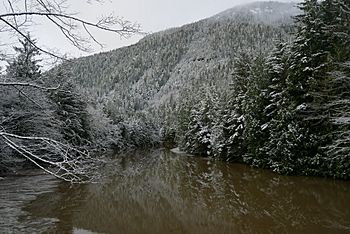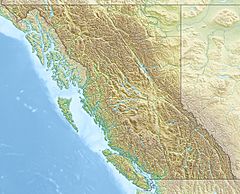McNeil River (Skeena River tributary) facts for kids
Quick facts for kids McNeil River |
|
|---|---|

Overlooking the McNeil River at the Gamble Creek Ecological Reserve
|
|
|
Mouth of McNeil River
|
|
| Country | Canada |
| Province | British Columbia |
| District | Range 5 Coast Land District |
| Physical characteristics | |
| Main source | Minerva Lake Coast Mountains 178 m (584 ft) 54°16′43″N 129°58′41″W / 54.27861°N 129.97806°W |
| River mouth | Skeena River 5 m (16 ft) 54°11′48″N 129°58′56″W / 54.19667°N 129.98222°W |
| Length | 13 km (8.1 mi) |
| Basin features | |
| Basin size | 41.4 km2 (16.0 sq mi) |
The McNeil River is a small river in British Columbia, Canada. It flows into the larger Skeena River. The river starts at Minerva Lake in the Coast Mountains. It then flows south for about 13 km (8.1 mi).
The McNeil River's water eventually joins the Skeena River. This happens near a place called Tyee Bank. This area is close to Port Essington. It is also about 25 km (16 mi) southeast of Prince Rupert. The land area that drains into the McNeil River is about 41.4 km2 (16.0 sq mi). This area is called its watershed. The average amount of water flowing in the river is 4.07 m3/s (144 cu ft/s) each year.
The land around the McNeil River belongs to the Tsimshian First Nations. This includes the Metlakatla First Nation. These groups are part of the Tsimshian Tribal Council.
Contents
Where is the McNeil River Located?
The McNeil River begins at Minerva Lake. This lake is found in the Kitimat Ranges. These ranges are part of the large Coast Mountains. The river flows south from the lake. It passes through another unnamed lake. Many smaller streams flow into the McNeil River. The biggest one is called Gamble Creek.
Both Gamble Creek and the lower part of the McNeil River flow near the Gamble Creek Ecological Reserve. This reserve is a special protected area. The type of ecosystem in the McNeil River watershed is called "Coastal Western Hemlock" or "Mountain Hemlock." These names describe the kinds of trees and plants that grow there. The area is part of the Hecate Lowland ecosection.
Plants and Animals of the McNeil River
The lower parts of the McNeil River watershed have thick forests. These forests are mostly made up of Western hemlock trees. You can also find some lodgepole pine and western redcedar trees. Some very old amabilis fir trees, over 300 years old, also grow here.
- Understory Plants: Below the tall trees, you can find many smaller plants. These include Alaskan blueberry and salal. Other plants are false azalea and deer fern. Different types of mosses also cover the ground.
Higher Elevation Plants
Higher up in the mountains, the forests change. They become more scrubby and boggy. These areas have mountain hemlock and yellow cedar trees. Some lodgepole pine trees are also found here.
- Understory Plants: The plants growing under the trees include Labrador tea. You can also see bog cranberry and lingonberry. Other plants are mountain heathers and cloudberry. Fernleaf goldthread and rose twisted stalk also grow here. Sphagnum moss is very common.
- Boggy Area Plants: In the really wet, boggy spots, you might find muhly grass. There's also beak-rush and deer cabbage. Look out for sundew, which is a carnivorous plant. Swamp gentian and White marsh marigold also grow in these wet areas.
Fish in the River
The McNeil River is home to many fish. It is an important place for different types of salmon. These include coho salmon and pink salmon. Other fish that live in the river are Dolly Varden trout and cutthroat trout.
Human Activities in the Watershed
People have used the McNeil River watershed for logging since the late 1960s. This has involved cutting down many trees in large areas.
See also


